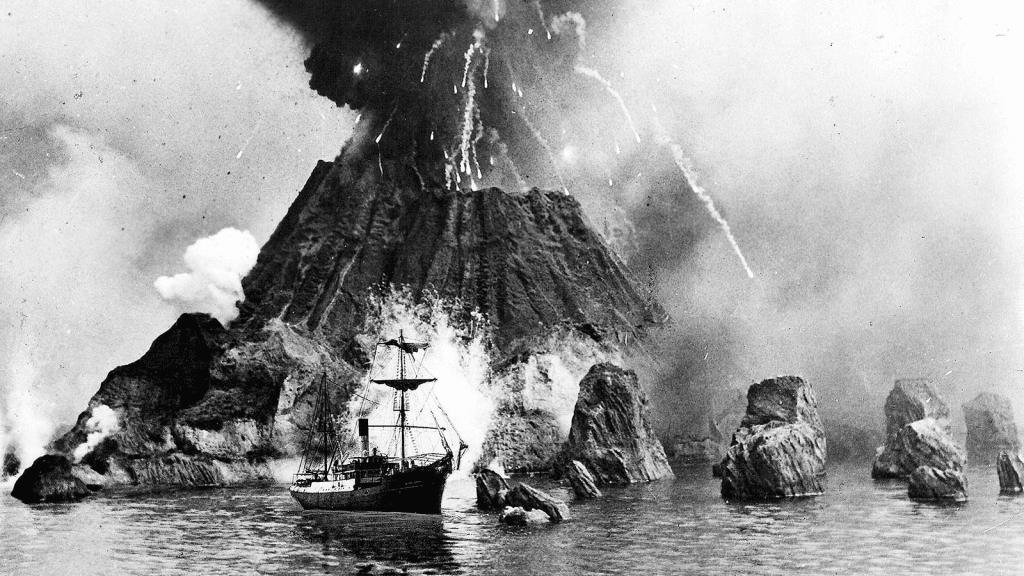A Cataclysm Heard Around the World
On August 27, 1883, the world witnessed one of the most violent volcanic eruptions in recorded history. Krakatoa, a volcanic island nestled between Java and Sumatra in Indonesia, exploded with a force so immense that it left an indelible mark on human history. The sound of the eruption was not just loud it was earth-shattering. People heard the blast as far as 3,000 miles away, across the Indian Ocean. Sailors in the Bay of Bengal and even in Western Australia reported the tremendous boom.

To put this into perspective, the force of Krakatoa’s eruption was equivalent to approximately 200 megatons of TNT over 13,000 times more powerful than the atomic bomb dropped on Hiroshima. For many, it was as if the sky had been torn apart.
Unleashing the Sky’s Fury
The eruption didn’t just produce a terrifying noise. It sent a towering column of ash and debris more than 50 miles into the atmosphere. This immense ash cloud blotted out the sun, casting eerie twilights and blood-red skies across the globe. Dust particles circled the Earth, disrupting weather patterns and leading to dramatic changes in climate.
Video: Krakatoa Eruption Real Sound (1883)
Average global temperatures dropped by more than 2 degrees Fahrenheit in the year following the eruption. Harvests failed in some regions, and vivid sunsets painted orange, purple, and red by airborne ash were reported as far away as Europe and the Americas.
Tsunamis and Tragedy
The true horror, however, unfolded at sea level. When Krakatoa blew, much of the island collapsed into the ocean. This sudden displacement created a massive caldera and generated tsunamis that crashed into nearby coastlines with devastating force.
Waves soared over 100 feet high, demolishing coastal towns and sweeping away entire communities in Indonesia. In total, over 36,000 people lost their lives many of them to these monstrous tidal waves. Some estimates suggest the actual number may have been even higher, given the limitations in communication and recordkeeping during that era.

The Island That Vanished
Krakatoa, once a 2,600-foot volcanic mountain, was reduced to fragments. More than two-thirds of the island vanished during the eruption, swallowed by the sea. The sheer violence of the event permanently altered the geography of the Sunda Strait.
Ships navigating the region found new reefs, underwater hazards, and shifting coastlines. For months after the eruption, the sea bubbled and steamed. The area remained geologically active, and the memory of Krakatoa lingered like an open wound in the minds of survivors.
Video: Volcano Eruptions Size Comparison (2021)
The Birth of Anak Krakatau
In 1927, more than four decades after Krakatoa’s destruction, a new island emerged from the ocean literally born from the ashes. It was named Anak Krakatau, or “Child of Krakatoa.” This young volcano continues to grow and erupt periodically, serving as a constant reminder that the Earth’s power lies just beneath our feet.

Anak Krakatau erupted violently in 2018, triggering another deadly tsunami that killed hundreds in nearby coastal areas. The volcano remains active and monitored closely by Indonesian authorities and global geologists alike.
A Global Legacy
The eruption of Krakatoa did more than devastate an island and its surroundings it reshaped scientific understanding of volcanic eruptions and their global impacts. It was one of the first major natural disasters to be extensively reported and studied in the modern era. Telegraph lines and newspaper reports carried the story around the world, uniting humanity in awe and fear of nature’s fury.
The event also inspired works of art, literature, and scientific research that continue to influence how we perceive and respond to volcanic hazards. Scientists today still refer to Krakatoa when modeling future supervolcanic events and understanding atmospheric changes caused by major eruptions.

Conclusion: The Fiery Voice of the Earth
Krakatoa’s explosion in 1883 stands as a haunting monument to the power of our planet. It is a vivid reminder that nature, for all its beauty, holds forces capable of reshaping the Earth in moments. As Anak Krakatau smolders on, scientists and citizens alike keep watch aware that history can erupt again at any time.
Understanding the legacy of Krakatoa is not just about remembering the past. It’s about respecting the raw, uncontainable power of nature and learning how to coexist with it in the future.


